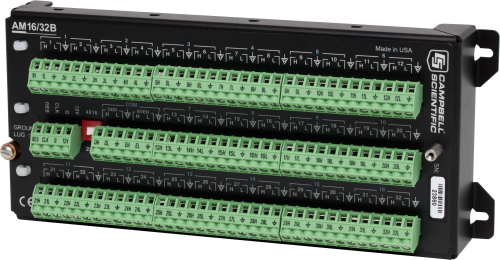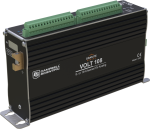
Connects many sensors to single datalogger






Overview
The AM16/32B multiplexer significantly increases the number of sensors that can be measured by a Campbell Scientific datalogger. It interfaces with the datalogger and adds terminals for wiring additional sensors of almost any type.
Read MoreBenefits and Features
- Significantly increases the number of sensors the data logger can measure
- Can multiplex 16, 32, or 48 sensors
- Supports many types of sensors including thermistors, potentiometers, strain gages, vibrating wires, reflectometers, and soil moisture blocks
- Decreases the cost of cabling individual sensors on long wire runs
- Allows a relay address to be used to go directly to a specific channel—reducing power consumption and wear on the relay switches
- Electrical surge protection via gas tubes on all analog I/O, and varistors or TVS diodes on all other connections
- Prevents sensor-cable damage by providing strain relief for sensor leads and independent routing for sensor shield lines
- Eliminates the requirement for dc blocking capacitors for gypsum soil moisture blocks, significantly reducing sensor cost
Images










3D/CAD Files:
Detailed Description
Depending on sensor type, the AM16/32B can multiplex 16, 32, or 48 sensors. Up to six AM16/32Bs may be connected to the same data logger, depending on the number of control ports and analog inputs available.
The AM16/32B either multiplexes 16 groups of four lines (a total of 64 lines) through four common (COM) terminals. Alternatively, a manual switch setting allows the AM16/32B to multiplex 32 groups of two lines (also a total of 64 lines) through two COM terminals. A cable connects the common terminals to data logger analog inputs, excitation channels, or ground as required by the sensor. The data logger controls the multiplexer using two control ports, or one control port and one excitation channel.
Electrical Surge Protection
The equipment is protected from electrical surges using gas tubes on all inputs. A 35 V varistor is connected between the shield ground and ground lug to provide surge protection. The Reset, Clock, and +12 V terminals are protected by 18 V TVS diodes.
Compatibility
Please note: The following shows notable compatibility information. It is not a comprehensive list of all compatible products.
Dataloggers
| Product | Compatible | Note |
|---|---|---|
| 21X (retired) | ||
| CR10 (retired) | ||
| CR1000 (retired) | ||
| CR1000X (retired) | ||
| CR10X (retired) | ||
| CR200X (retired) | ||
| CR206X (retired) | ||
| CR211X (retired) | ||
| CR216X (retired) | ||
| CR23X (retired) | ||
| CR295X (retired) | ||
| CR300 (retired) | CRBasic programming experience is recommended, as the AM16/32B with the CR300 series is not currently supported in Short Cut. | |
| CR3000 (retired) | ||
| CR310 | CRBasic programming experience is recommended, as the AM16/32B with the CR300 series is not currently supported in Short Cut. | |
| CR350 | CRBasic programming experience is recommended, as the AM16/32B with the CR350 series is not currently supported in Short Cut. | |
| CR500 (retired) | ||
| CR5000 (retired) | ||
| CR510 (retired) | ||
| CR6 | ||
| CR800 (retired) | ||
| CR850 (retired) |
Mounting Equipment
| Product | Compatible | Note |
|---|---|---|
| ENC10/12 | Mounted sideways only. | |
| ENC10/12R | ||
| ENC12/14 | ||
| ENC14/16 | ||
| ENC16/18 | ||
| ENC24/30 | ||
| ENC24/30S |
Additional Compatibility Information
Data Logger Considerations
Programming
A series of data logger instructions control the AM16/32B operation (measurement instructions that are repetitive are generally contained within a programming loop; in the CR800-series, CR1000, CR3000, and CR5000, this functionality is available in the SubScan instruction).
Sensors
Compatible sensors include thermistors, potentiometers, load cells, strain gages, vibrating wire or vibrating strip transducers, water content reflectometers, and soil moisture blocks. The AM25T is recommended for multiplexing thermocouples.
Maximum Number of Sensor Connections
The maximum number of sensors multiplexed through one AM16/32B depends on the type(s) of sensors measured. For example, assuming identical sensors, the AM16/32B can multiplex up to:
- 32 single-ended or differential sensors that require two wires (for example, thermistors, half bridges)
- 16 single-ended or differential sensors that require four wires (for example, full bridges, four-wire half bridges)
- 32 vibrating wire sensors (16 with temperature) in conjunction with an AVW1, AVW4, AVW100, or AVW200-series Vibrating Wire Interface
- 48 half-bridge measurements (assumes common excitation and completion resistors at the data logger)
- 48 CS616 Water Content Reflectometers (assumes common excitation)
- 32 gypsum soil moisture blocks (model 223 or 253). The AM16/32B eliminates the requirement for dc blocking capacitors, significantly reducing sensor cost
Power Considerations
The AM16/32B draws less than 210 microamps quiescent, 6 milliamps active—so power considerations are heavily tied to the percentage of time in quiescent versus active states. Use of a relay address can reduce power consumption by minimizing the time spent in an active state.
In most applications, the data logger’s sealed rechargeable power supply should be more than sufficient; the data logger’s alkaline power supply could be used in applications where the multiplexer is activated infrequently.
Enclosure Considerations
The AM16/32B operates in most field conditions but requires a non-condensing environment. A weather-resistant enclosure equipped with desiccant is required for field use. A smaller enclosure is often used if the multiplexer is housed at a distance from the data logger.
If the AM16/32B is to be housed in the data logger’s enclosure, one AM16/32B, a CR800, CR850, CR1000, CR3000, or CR10X datalogger, and a PS150 power supply will fit in an ENC12/14. For convenience in wiring, a larger enclosure (e.g., ENC16/18) is recommended.
Software
LoggerNet, PC400, and ShortCut are compatible with the AM16/32B. Short Cut software (available at no charge from our website) supports simple programming and generates wiring diagrams for AM16/32B applications; early versions of Short Cut did not support multiplexers. Please reference the notes in the compatibility table for data loggers.
Specifications
| -NOTE- | The protection on the reset, clock, and +12 V inputs are provided by 18 V TVS diodes. |
| Power | Unregulated 9.6 to 16 Vdc |
| Scan Advance | Occurs on the leading edge of the clock pulse transition (from below 1.5 V to above 3.3 V) |
| Minimum Clock Pulse Width | 1 ms |
| Maximum Actuation Time for Relay | 20 ms |
| Relay Operation | Break before make |
| Initial Relay Resistance, Closed | 0.1 ohm |
| Maximum Switching Current |
500 mA (Switching currents greater than 30 mA [occasional 50 mA current is acceptable] will degrade the contact surfaces of the mechanical relays and increase their resistance.This will adversely affect the suitability of these relays to multiplex low voltage signals.Although a relay used in this manner no longer qualifies for low voltage measurement, it continues to be useful for switching currents in excess of 30 mA.) |
| Maximum Switching Voltage |
50 Vdc A voltage divider such as the VDIV10:1 may be needed between the AM16/32B and the data logger to stay within the input limits of the data logger channel. |
| Minimum Contact Life | 5 x 107 operations |
| Maximum Contact Voltage Rating | 70 V |
| Maximum Voltage | 8 Vdc (clock level) |
| CE Compliance |
|
| Surge | Complies with IEC61000-4-5, test level 3 (±2 kV, 2 ohm coupling impedance) |
| Operating Temperature Range |
|
| Dimensions | 23.9 x 10.2 x 4.6 cm (9.4 x 4.0 x 1.8 in.) |
| Weight | ~680 g (~1.5 lb) |
ESD |
|
| Air Discharge | Complies with IEC61000-4-2, test level 4 (±15 kV). |
| Contact Discharge | Complies with IEC61000-4-2, test level 4 (±8 kV). |
Typical Current Drain |
|
| Quiescent | < 210 µA |
| Active |
|
Reset Levels |
|
| Inactive | < 0.9 V |
| Active | 3.3 to 8 V |
Documents
Product Brochures
Manuals
Videos & Tutorials
Downloads
AM16/32B Example Programs v.1 (8 KB) 11-12-2020
CR6, CR1000X, and CR300 programs demonstrating taking multiple measurements using an AM16/32B relay multiplexer. Examples cover single-ended, differential, full-bridge (107 temperature sensor), and CS616 measurements.
Frequently Asked Questions
Number of FAQs related to AM16/32B: 1
-
A practical maximum is to connect one multiplexer per every two control terminals on the data logger. Control terminals can be shared between multiplexers to increase the number of connected multiplexers. Sharing terminals, however, requires more complex wiring and programming. Users who would like to connect more than one multiplexer per every two control terminals are advised to contact a sales or support engineer at Campbell Scientific for assistance.
Casos de estudio
Overview The Udhampur-Srinagar-Baramulla Rail Link (USBRL) project is of national importance as it connects Kashmir to the......read more
The Expressway S19 represents a critical link in Europe’s transportation network, stretching 570 km (354.2......read more
Overview The reconstruction of the navigational lock system at the Iron Gate I Hydroelectric Power Station......read more
Located beneath a steep canyon near Douglas, Wyoming sits LaPrele Dam, privately owned by LaPrele......read more
In 2010, Trenton and Amalga, two northern Utah towns separated by only a few miles,......read more
The four main spans of the Huey P. Long Bridge extend nearly 2,400 ft over......read more
Amidst a vast expanse of farming and range lands, bridge designers from the Montana Department......read more










